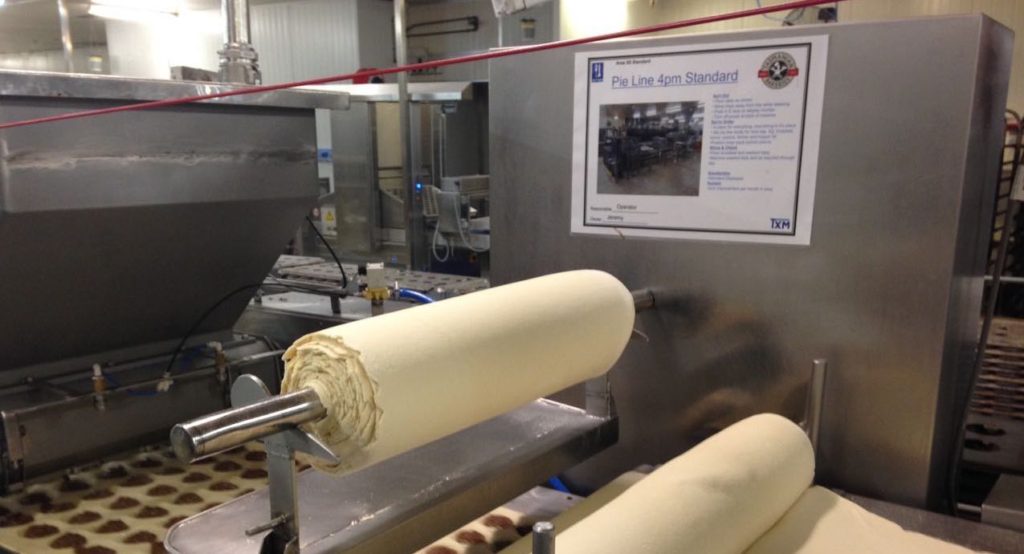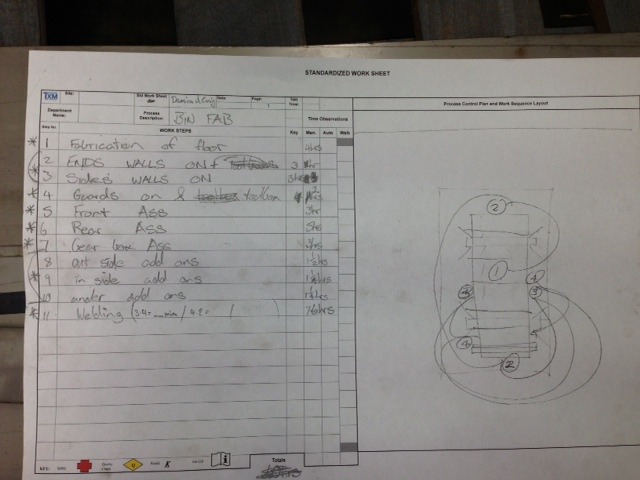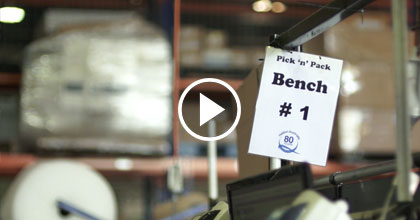A common teaching from Lean methodologies is “Without standardization; you cannot achieve effective Kaizen, develop a Lean management structure or even support a continuous improvement program.” Standardised work is an integral part of Lean Manufacturing.
The goal of standardizing the work is to reduce the variability in a process by documenting and training operators in the best way to perform that process, while achieving the required outcomes in Quality, Safety, Delivery and Cost. Standardized work is the least-used tool in Lean, but arguably the most powerful one.
Once Standard Work is in place, it becomes the baseline for all future improvements.
When you think about a problem that occurs in a process or service, the source of problem comes down to one of three conditions:
1. A lack of a standard
2. The standard was not followed
3. The standard needs improvement
Having Standard Work in place means that we are trying to address these causes by creating a documented baseline and that we train to the baseline standard. Then we audit the standard to confirm it is being followed and is the current best practice.
How to Create Practical Lean Standard Work?
We begin with integrating the belief that standard work is a critical process across all levels of the business. Every level is required to take part in developing work standards before initiating any formal improvements. Defining the behaviors at each level of management is the starting point along the path to effective Standard Work. Over time, each level supports and delivers the “one way of working” that others can follow.
Creating standards is a large task and adds additional work to the current processes. A common comment often heard is “I am already overloaded and this is just not possible”. Standard Work is perceived as less important than daily tasks and there is no time to pause and reflect – Do we use the best methods in our work? As Peter Drucker says “There is nothing so useless as doing efficiently that which should not be done at all.”
Each level of management has a set of primary behaviors to observe in order to develop Standard Work.
As Senior leaders:
- Ensure standard principles are understood
- Embedded the desired behaviors in your teams
- Include continuous improvement as part of your daily work
As Managers:
- Maintaining processes and standards
- Deliver outcomes and drive at behaviors
- Check that Standard Work is being followed
- Any deviation from a standard should be clearly visible and immediately corrected
As Front Line Leaders:
- Identify best practices and developed standards
- Become the disciplined in the following Standard Work
- Adopt the new standard when a better way is found.
- Train and coach other in Standard work
Gathering the Detail for Standard Work with a Template
If we start with Taiichi Ohno, author of Toyota Production System, he draws your attention to the standardized worksheet template and explains “Standardized worksheets and the information contained in them are important elements of the Toyota Production System.”
The “Standard Work Sheet” is a well known and widely used template to collect and define a work task. It is designed to combine materials, human effort and machines that are needed to produce a set task. Using this template has been proven to be more efficient during training rather than a supervisor teaching from personal experience. By using Standard Work we can improve the training of new employees and within a short period, they are capable of working independently.
Taiichi Ohno continues to explain that “For a production person to be able to write a standard worksheet that other workers can understand, he or she must be convinced of its importance…. High production efficiency has been maintained by preventing the recurrence of defective products, operational mistakes, and accidents, and by incorporating workers’ ideas. All of this is possible because of the inconspicuous standard worksheet” Chapter 12, The Toyota Way, Jeffrey Liker, McGraw-Hill Osborne Media
It becomes important to get the work sequence understood in a practical and simple way to balance out the efforts required to produce a Standard Work. Start small and over time increase the details for improving the sequences. Standard Work aims to be the benchmark of the “way we work here” o that it can be woven into the culture of the organization.
Determining a Standard Method

Often there are several ways to do a task. However, one of these ways is the most efficient use of resources. Any individual can choose to do things in their own preferred way and it may prove to be the best method. However, an organization cannot rely on that method in case they take leave or move to another role. Also, that best approach remains the specialty of one individual and not within the organization. Over time, the skills needed to performance a task can become lost and the process of relearning is repeated.
The Standard Work approach is established so that it is practical and useful to everyone and free of difficulty. Standard Work is also not perfect and is considered a living document that develops over time. But remember, standard work will die very quickly if it is ignored.
Start with Purpose
Practical Standard Work aims to achieve two key points; to maximize efficiency and to minimise waste in any task. In establishing the best work sequence we need to consider two additional conditions; how do we meet the Takt time and defining the in-process inventory to meet the customer demand.
To achieve this we look at:
- The amount of time which is needed complete the process to meet the customer demand. – Takt time for the process
- What is the order of the step by step operations that are needed – Work sequence
- The specified amount of standard inventory that is required to be in the process at any given time to support the Standard Work sequence
How to Establish the Best Work Sequence
- Collect data to define the most efficient work sequence.
- Review the sequence with the team to understand any constraints and concerns.
- Trial the best practice sequence up to ten times, with different people in your team. If a range of employees can repeat the standard, then we have Standard Work.
- The Standard Work is documented and used to help employees repeat the work along with creating baseline training material. Each trial is observed and recorded – maybe even a video is taken for reviewing offline.
The 3 Elements of Standard Work
1. Create Standards
The best way to agree on how to do the work is to first agree on what needs to be done. Often, we find ourselves discussing the best method and then find out that there are different or inconsistent understandings of what exactly is required.
This sounds very basic, but it is fundamental for all involved to have a fast & efficient way of defining standard work. In a production environment this can be extremely technical around product specifications and manufacturing methods. In a service environment this requires traditional experts to all agree on exactly what the process should deliver.
Every process has a customer who requires the work to be clearly defined. This adds a dimension of internal customer service where the next person in the process is the ‘internal’ customer/employee working on this process. This is why you should consider involving all stakeholders for defining standard work.
2. Standardize the Method
In their famous article, Spear and Bowen state that one of the key elements of the DNA of the Toyota Production System is that all work is highly standardized in terms of method, timing, and sequence. Tasks into small steps to define method timing and sequence and create standard work.
Getting a group of people with different experience levels to each list their sequence of tasks is a suitable starting point. Then get at least two of the people to each analyze the steps and agree what the steps are. Safety is a key factor in this step and often a risk assessment can reduce ergonomic strain and define the best sequence of motions.
Once this is done the group get together and each practice the sequence until they can do the work from memory, without hesitation. For a short cycle time of less than a minute this can be about 30 times. For longer cycle times you might only ever do the task once and the estimator needs to be the standard work coach. The best method is the sum of the shortest time for each step.
3. Standardization to Challenge and Improve the Method
The third step is to ensure people can confidently do the task. Achieving the required outcome in the required time following the safe working method.
There are different ways of identifying improvements:
As new people learn the task, they will challenge the method and often come up with a better way. Culturally this adds an expectation to challenge process and change the method in a controlled fashion from the very first process they learn.
Set an expectation for people to self-challenge the way they work and identify improvements. This could be through knowledge and discussion about waste types. Ge t your teams to talk about local examples of the eight wastes of transport, inventory, motion, over-processing, over-production, defects, and under utilized human potential in their process. This can help generate ideas, bring awareness and prompt improvements.
Lastly, to encourage other people in the business to spot hesitation moments. These are moments in the process where team members hesitate while they do the work. Leaders need to use their peripheral vision to see hesitation moments. Team leaders & co-workers can often point out hesitations and discuss why this happened with the person who experienced the hesitation.
Standardizing your processes will create a step change in efficiency for your whole business. Considering all of your stakeholders, both internal and external will give you a better understanding of where you need to focus your resources and time.
Final Words on Lean Standard Work
Practical Lean Standard Work is a foundation element of Lean manufacturing methodologies. Without it, the gains made from the other Lean tools, such as Visual management, 5S, work cells, flow production, and continuous improvement, will only be short lived. Standard Work prevents the slide back to less efficient work practices.
Implementing standardized work is not an easy task. The time needed to collect the detailed steps and information to be uncovered, often reveals more questions and concerns. It can be difficult to start when work demands are high and resources are tight. Performing baseline observations are time-consuming, and often an unpopular activity out on the shop floor. However, the hard work and the constant effort to improve are worthwhile, as skills develop and the speed of creating Standard Works sheets increases.
This results in improved quality, productivity, safety, skills training and customer satisfaction.







